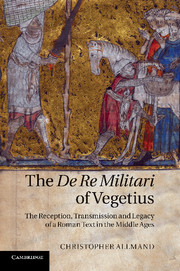 The De Re Militari of Vegetius
The De Re Militari of Vegetius from Part II - The transmission
Published online by Cambridge University Press: 07 October 2011
Both our perception of the understanding of Vegetius’ text achieved by readers in the Middle Ages, and the methods used to foster that understanding, may be enhanced by an examination of the drawings and illuminations found in some surviving manuscripts. Sketches added in the margins are normally related to the passage in which they appear. In seeking either to summarise or to emphasise its contents, or to explain, visually, the meaning of a word (often a technical term), they underline the importance attached to a particular passage by immediately attracting the reader's eye to it. They may be classified into broad groups. One represented military formations, such as squares, wedges and circles, the way in which an army might be conceived in diagrammatic form; or how the battle line should be drawn up. A second, smaller group consisted of those which contained drawings of weapons in the margins, the drawings normally being attempts to illustrate references in the text close to which they were to be found: the sword, to be used for thrusting rather than for slashing; the simple bow and arrow; the sling; the stones to be used in defence of a wall; two weapons of aggression, Greek fire (‘ignis grecus’) and the swing-beam (‘tolleno’). In another manuscript the drawing of a rat underlined the need for hygiene as a way of keeping the army healthy, while the story of the Roman matrons cutting their hair to supply the city's broken tension engines is depicted in the drawing of two women in the margin.
Attention has been drawn above to some of the practical problems faced by the translators (or modernisers) of Vegetius’ text, and how their solutions can serve as indications of how the text was regarded, and of its importance and significance to their own age and culture. Worthy of attention, too, since they help us understand how the work was interpreted by those who created and illuminated new copies (both Latin and vernacular) were a number of manuscripts enriched with illuminations ranging from full folio size to tiny vignettes incorporated into large capital letters. By the way they ‘visualise’ how aspects or, indeed, the entire content of the work may have been understood by the artist or the patron at whose bidding he worked, illuminations in a text have much to reveal about the approach taken by those who created them. Illuminations are, therefore, important for what they indicate were regarded as key features of the work. The De re militari read as a guide to the duties of knighthood, for instance, is strongly suggested by the mounted knight in armour, with helm, draped in red, bearing a sword, incorporated into the capital letter ‘A’ of its very first word, ‘Antiquis’, in the fourteenth-century manuscript copied in Italy and destined to be owned by Petrarch; while another rich manuscript, copied in the mid-fifteenth century on the orders of Alfonso V, king of Aragon, contains a full-folio illumination of a knight on horseback.
To save this book to your Kindle, first ensure no-reply@cambridge.org is added to your Approved Personal Document E-mail List under your Personal Document Settings on the Manage Your Content and Devices page of your Amazon account. Then enter the ‘name’ part of your Kindle email address below. Find out more about saving to your Kindle.
Note you can select to save to either the @free.kindle.com or @kindle.com variations. ‘@free.kindle.com’ emails are free but can only be saved to your device when it is connected to wi-fi. ‘@kindle.com’ emails can be delivered even when you are not connected to wi-fi, but note that service fees apply.
Find out more about the Kindle Personal Document Service.
To save content items to your account, please confirm that you agree to abide by our usage policies. If this is the first time you use this feature, you will be asked to authorise Cambridge Core to connect with your account. Find out more about saving content to Dropbox.
To save content items to your account, please confirm that you agree to abide by our usage policies. If this is the first time you use this feature, you will be asked to authorise Cambridge Core to connect with your account. Find out more about saving content to Google Drive.